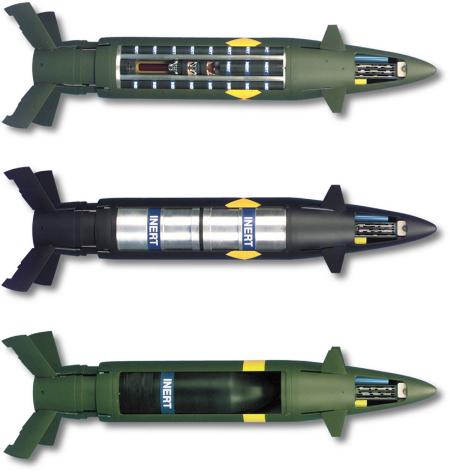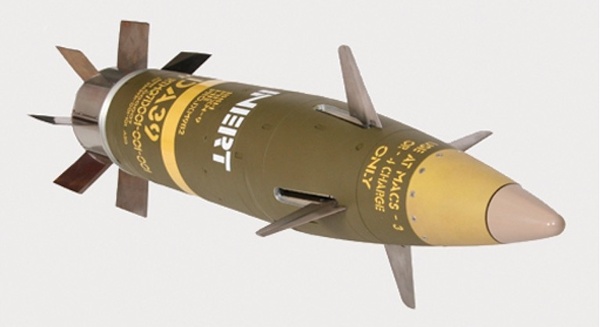Raytheon Excalibur (155 mm Projectile M982)
In 1986, the U.S. Army Tank-automotive and Armament Command, Research, Development and Engineering Center (TACOM/ARDEC) began the development of a rocket-assisted precision-guided 155 mm gun projectile. The projectile's payload was to be 85 XM80 DPICM (Dual Purpose Improved Conventional Munition) bomblets, and it was therefore known as the 155 mm Extended Range DPICM Projectile, M982. Ballistic tests of the basic design in early 1997 were successful, and in February 1998, Raytheon was awarded an EMD (Engineering & Manufacturing Development) contract for the XM982 projectile. Later the name Excalibur was allocated to the weapon.
 |
| Photo: Raytheon |
| XM982 (original fin design) Warheads (from top): 64x M85 DPICM, 2x SFM, Unitary |
The Excalibur round can be fired from several types of 155 mm artillery, including the M198 and M777 towed howitzer, and the M109A6 "Paladin" self-propelled howitzer (SPH). The XM2001 "Crusader" SPH, for which the XM982 was originally developed, was cancelled in May 2002. The Excalibur's guidance system consists of a GPS-aided IMU (Inertial Measurement Unit) and the projectile is stabilized and controlled by flip-out fins and canards. The original design had four tailfins, but this was changed to a different design with eight smaller fins, which lie flush around the body before deployment. Although the Army's original XM982 design, which was tested in 1997, featured a base-burning rocket assembly for extending the range, Raytheon's EMD design has no propulsion of its own. The range extension by the non-ballistic flight path, made possible by the aerodynamic control surfaces, is enough to fulfill the requirements. With current artillery, Excalibur has a range of about 40 km (25 miles) with an accuracy of 4 m (13 ft) CEP or better.
 |
| Photo: U.S. Army |
| XM982 (inert round) |
The first payload to be integrated with Excalibur was originally planned to be a submunition warhead with 64 M85 DPICM bomblets (the same as used by the M26A1 MLRS rockets). However, this was changed to a unitary high-explosive warhead in the so-called "Increment I" of Excalibur.
The first unguided test flight of an XM982 round occurred in September 2001, and in July 2002 a maximum energy test shot proved the survivability of the guidance electronics. After accelerated development, Excalibur Increment Ia-1 XM982, with a reduced range of 23 km (14 miles), entered service in 2007. In the same year, it was used successfully in combat in Iraq. The next development step was the Increment Ia-2, M982. It featured jamming resistance in the GPS receiver and 40 km (25 miles) range. In 2018, the full-capability Increment Ib, M982A1 reached full-rate production. It has a further improved jamming-resistant GPS unit, and upgraded software to allow user-defined projectile trajectories. In a firing test in 2020 from an M1299 ERCA (Extended Range Cannon Artillery) howitzer, Excalibur reached a range of 70 km (43 miles).
 |
| Photo: U.S. Army |
| M982 (exact version unknown) |
Raytheon has privately developed additional variants. Excalibur S adds a semi-active laser seeker to the round, for high accuracy in GPS-denied environments. Excalibur HTK has an anti-armor warhead and a seeker for autonomous targeting of moving targets, and Excalibur N5 is a variant for naval 5-inch guns.
Specifications
Note: Data given by several sources show slight variations. Figures given below may therefore be inaccurate!
Data for 155 mm Projectile, M982A1:
| Length | 1.0 m (39.2 in) |
| Diameter | 155 mm (6.1 in) |
| Weight | 48 kg (106 lb) |
| Range | 40 km (25 miles) |
| Warhead | 22 kg (48.5 lb) PBXN-9 Unitary |
Main Sources
[1] Raytheon: Excalibur Projectile
[2] Wikipedia: M982 Excalibur
[3] U.S. Army:
Excalibur Precision 155 mm Projectiles
Back to Directory of U.S. Military Rockets and Missiles, Appendix 4
Last Updated: 27 January 2024